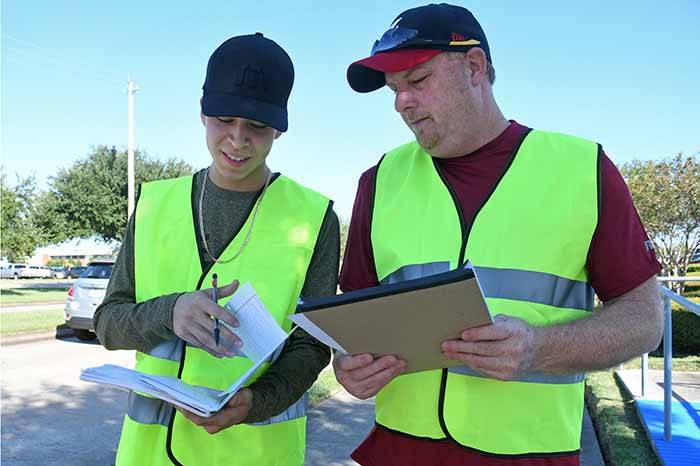From restoring prairie to reclaiming identity, students serve to learn

As wind stirs the cattails and cicadas buzz, San Jacinto College students in work gloves and rubber boots shovel earth to make room for new prairie grasses at Sheldon Lake State Park.
Sweat beads on foreheads under the September sun. Some students crack the dry ground with their shovels, while others schlepp water in kitty litter jugs from a trailer bed to the coastal prairie worksite. Slowly, foot-high switchgrass, eastern gamagrass, yellow Indian grass, and bluestem pop up beside their older siblings.
Some might call it old-fashioned hard work. But these smiling San Jacinto College North Campus Biology II students, working alongside professor Dr. Tyler Olivier and park rangers, call it service learning. Olivier peppers the work with discussion of monocots, plant reproduction, and urban benefits of prairie conservation. It's learning in the field — literally.
Skin in the game

Olivier, a service learning campus liaison, calls service learning a high-impact practice
that not only builds character but also adds context to the coursework.
"I can tell you something all day, but until you get hands-on experience, you don't really connect with the material," he said.
A 'community' college
Service learning crosses all fields.
At Central Campus this fall, Dr. Judy Maima, professor of child development and education, offered service learning opportunities in Pasadena ISD in her Introduction to Teaching Profession and Introduction to Special Populations courses. For two hours each week, future teachers tutored younger students in reading and writing or assisted with educational and extracurricular activities at elementary schools through Pasadena ISD's Helping One Student to Succeed and Texas ACE programs.
In the Cooperative Education - Legal Assistant/Paralegal service learning course, North Campus students volunteered for the Make It Right event hosted by the Harris County District Attorney's Office and Beacon Law this fall. According to paralegal program director Jeanette Liberty, students helped generate hundreds of cases and prepare legal documents so Houston residents could have warrants vacated, driver's licenses restored, and criminal records expunged or sealed.
Thanks to the event, these individuals could mend mistakes to provide a better future for their families.
"San Jac is not just about providing quality education at a low cost," Liberty said. "We also give back to our community and produce graduates who understand the importance of helping others. The College isn't just located in the community — it's an important part of the community."
Multi-faceted badge

White wanted students to see that improving traffic is not just about (1) enforcing
law but also about (2) educating the public and (3) engineering solutions. At the
end of the course, students presented their findings to police and recommended one
or more of these three E's.
Throughout the semester, Ray Bush and a teammate observed school bus pick-up and drop-off on Central Campus' Cunningham Drive to identify whether drivers were illegally passing stopped buses — a complaint police had received. While they didn't see anyone passing the buses, they witnessed another issue: drivers behind the buses sometimes speeding as they cut through a neighboring parking lot to avoid waiting.
"On the engineering side, we'd prefer the 'no passing' signs that already exist to have blinking lights that make people visually want to look," Bush said. "Also, have a patrol unit stationed in the parking lot to make people slow down, not think, 'How fast can I get home?'"
The service learning class freed police to focus on campus safety while students helped identify problems. Bush also appreciates traffic officers more, realizing their public presence is more often about collecting data to adjust speed limits and improve flow than about writing tickets. This is the professor's goal. A former police traffic sergeant, White wants to prepare students for service-oriented policing and remove some of the profession's stereotypes.
"We're not just crime fighters but problem solvers. My chief used to say, 'The moment the badge becomes about you, you've gone wrong,'" he said.
A tactile textbook
Whether restoring a natural habitat, mentoring younger students, clearing a record, or improving traffic, San Jacinto College service learning students go beyond the classroom not only to learn and build their resume but also to change their communities.
For instructors, service learning is a chance to engage students in a larger purpose.
"The world is bigger than the side of town they grew up in," Olivier said. "Students get to do something they never thought they could do."
For students, it's a chance to close the textbook and live the course material.
"If you have a choice of sitting in a classroom or getting out and doing something, get out!" Bush said.
Is your course service learning?
-
Search for the course at coursefinder.sanjac.edu.
-
After you click on the course, drop-down information will appear.
-
If the course is service learning, a symbol will appear beside the course number. Mouse over this for a message like “This class includes a 10-hour service learning project.”
